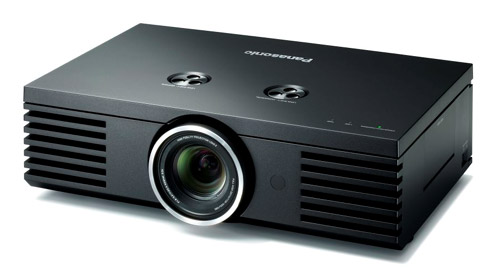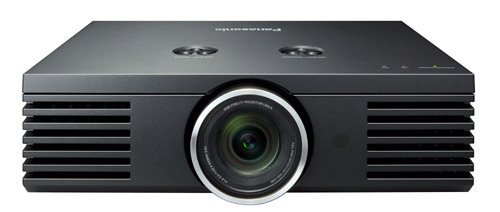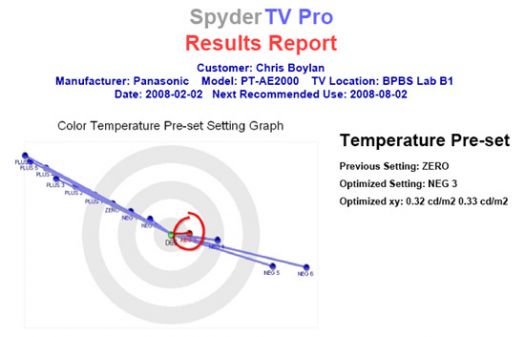Can a person be unfaithful to his home theater equipment? As loyal BigPictureBigSound readers can attest, I'm a huge proponent of Sanyo projectors. My first was the PLV-Z2, and I recently upgraded to the stellar 1080p PLV-Z2000. But when I saw the image produced by the Panasonic PT-AE2000U 1080p home theater projector, I have to confess I started having impure thoughts. (Oh, I hope Sanyo isn't reading this.)
I was reminded of my first HDTV - the Sony KV-34XBR800 – from five years ago. The first time I saw a pristine (over-the-air, at the time) HD signal, and completely fell in love with it. I vowed never to go back to standard-definition if at all possible. The AE2000U's picture brought me back to those days. Yes, it felt like the very first time (cue Madonna's "Like a Virgin").
The AE2000U is Panasonic's second foray into the 1080p projector market. Last year's PT-AE1000U was already an impressive entry, boasting Panasonic's typically deep blacks and earning our coveted four-star rating. The 2000 is everything its predecessor was but even more so, featuring vast, rich contrast, excellent color saturation (right out of the box), quick start-up time, a quieter fan and three HDMI inputs (pant, pant, excuse me, sorry). All at a significantly reduced price ($3,499 MSRP). Not sold yet? Read on.

Size does matter
Ok, so the 2000U may not be the most attractive projector in the world. Like the 1000U, it's a big, honkin' black box. It measures 5.1x18.1x11.8 inches (HxWxD) which, amazingly, is the exact size of the 1000U (how'd they fit all this extra goodness into the same size package?). The Sanyo PLV-Z2000, by contrast (no pun intended), is 5.7x15.7x13.6. So the Sanyo is a bit more of a cube than the rectangular Panny. Plus, the Sanyo has an Apple-esque white finish.
We're getting into strictly aesthetic territory here, but the Sanyo feels more pleasing to the eye to me. Of course, a lot of this will depend on where you're mounting your projector. If it's against a light-colored wall or ceiling, the Sanyo is a no-brainer. If it's tucked away in a darkened room, the Panny won't look out of place.
And speaking of mounting, the Sanyo still has the Panny beat on lens shifting. But you knew I was going to say that. No one does the 50% horizontal/100% vertical shifting the way Sanyo does. Still, the AE2000U's lens shift capability should be more than adequate unless you have the projector mounted to the extreme right/left or top of your viewing area.
But enough about looks, let's turn the damn thing on…
Faster than you can say "quick start-up time"
Projectors in general are known for needing warm-up time. The Sanyos typically give you a 30 second start-up screen with a little countdown display before the picture comes on. The older Panasonics did the same thing (though a bit faster). The AE2000U, though, did something I haven't seen before. I just started up. Ok, maybe it took about 5 seconds. But before I knew it, the picture was just on. Now, keep in mind, it still took about a minute for the projector to fully brighten, but that's to be expected (it's a lamp, after all). The experience reminded me of my Dad's old tube TV from the 70s warming up. It was a delight to see the picture come on so quickly.
The Panasonic's fan noise was definitely more audible than the Sanyo's whisper-quite fan (22db to the Sanyo's 19db). But it's a significant improvement over previous Panasonics. It was barely noticeable unless the room was completely quiet.
Focus!
Right out of the box, the Panny's picture appeared brighter and richer than the Sanyo's. Even with the lights on and no calibration I could tell the difference. Part of this is due to the fact that the Panasonic's factory presets are actually (no way!) well-calibrated, but also the default "Normal" setting is set at a fairly bright 900 ANSI lumens. The other modes (particularly "Cinema 1") looked even better, and less bright, with deeper color saturation. Of course, I'll have more to say about that in the next section.
The AE2000U has motorized zoom and focus capability (the Sanyo is manual). But despite the fact that it's pretty cool to be able to zoom and focus via the remote control, I found it much more difficult to get the Panasonic's focus exactly right this way. When you click the zoom or focus button once, it doesn't respond. You need to hold the button down – which isn't great for fine calibrations. I was surprised by this, but after a little work I was able to get it focused to my liking.
Next, I set my DVD player to a 480i output and ran through the Silicon Optix HQV test DVD. The Panasonic passed the "jaggies" tests (my personal favorite on name alone) with flying colors. The test featuring one bar rotating in a circle was flawless. For the three bar test, only the top had very minor jaggies, barely noticeable. And speaking of flying colors, the flag test was only slightly less successful than the test patterns. There were a few noticeable artifacts as the flag waved in the breeze, but the amount of stair-stepping distortion was still minor, and well within "passing" limits for this test.
On the "Film Detail" test (excerpt from "Super Speedway"), the projector took only a split second before the stadium bleachers looked perfect. This shows that the projector is able to detect the 3:2 cadence of the underlying film-based material quickly, which is important when displaying any interlaced content sourced from film material (DVDs and broadcast HDTV).
On the 1080i Silicon Optix test disc, the projector continued its strong performance, with virtually pixel perfect reconstruction of still and moving video content from 1080i to 1080p. With film-based 1080i content, there was a slight shimmer in the vertical line test patterns, but these results were better than virtually any other projector we have tested, and better than Panasonic's own DMP-BD30 Blu-ray Disc player.
In actual viewing, my tests with standard-definition content (non-HD cable) and SD DVDs looked very good, reinforcing these test results. And broadcast HDTV looked simply stunning. I only wished a different network carried the Super Bowl this year as our hometown Giants pulled out an exciting upset win, ending the seemingly unstoppable Patriots' winning streak. On the Panasonic, the 720p resolution of the Fox Super Bowl broadcast was a bit softer than a good 1080i live broadcast. It still looked amazing on the Panasonic, just not as amazing as it could have.

Cali-forni-bration
As I mentioned above, the Panasonic's presets were so well configured that this was probably the easiest calibration of any projector I've worked with. I could have been happy with the "Cinema 1" setting, but I had to give it a go with the Avia and SpyderTV Pro tools.
But before I started with those, I tried the AE2000U's unique "split-screen" calibration mode. The Panny allows you to freeze-frame an image (say, the opening cityscape in "Blade Runner") and choose a specific square area of that image. The Panasonic will then duplicate that area and lay the two images side-by-side, allowing you to make adjustments to one while comparing it to the original. This gets into real videophile territory here - for those enthusiasts who want their color, brightness, contrast, etc, setup just so. Still, it's a nifty feature, and one that I haven't seen on any other projectors.
After I was done playing with the side-by-side tool, I broke out the Avia DVD. I've always been a fan of this simple, easy-to-use calibration utility. Again, it didn't disappoint. I started with the Panasonic set to "Normal", I shut off the Dynamic Iris and Noise Reduction features and ran through the Avia's test. I came out with the following: Contrast 16, Brightness -1, Color -8, Tint 3, Sharpness 6 (obviously, these settings are specific to our screen and viewing environment and should not be considered optimal for anyone else's). As is often the case, the Avia results were a bit bright but they produced great depth of picture.
Next, I moved on to the Spyder (man). Surprising, the Spyder gave me a lot of trouble with the Panasonic. For some reason, it had trouble measuring the Contrast and had to repeat the process three times. [editor's note: on a different screen, we were not able to reproduce this problem, so it appears to have been a temporary idiosyncrasy of SpyderTV Pro].
Since the Panasonic's Contrast control goes from -64 to 64, this was a bit frustrating and time-consuming. Plus, the Panny's on-screen display appears at the bottom of the screen and was partially obscured by the Spyder colorimeter's tripod. Fortunately the Panasonic remembers where it was in the picture settings menu so getting in and out of the menu adjusting the picture settings was otherwise fairly painless.
And happily, once I got through it all, the results were worth it. On my Goo Systems "Digital Grey" screen, the Spyder ended up with Contrast 9, Brightness -4, Color -8, Tint 4, Sharpness 0, Color Temp -6. Red and blue contrast (aka "gains") +1; Red Brightness (aka "cuts") -1. [editor's note: on a white screen, the color temperature setting that tracked closest to 6500 degrees was actually "-3" and other settings were also slightly different from those specified above. As Joe states earlier, best results will always be obtained by calibrating your projector with your specific screen].

The Avia might have produced a brighter image, but the Spyder gave me a more vibrant, richer picture.
Someone closed the screendoor
Panasonic sparked a bit of controversy some time ago when it announced the implementation of its "SmoothScreen" filter technology – a technique which aims to give a sharper picture by "smoothing" the pixel structure of the image. Some critics said that this technology would compromise the sharpness or clarity of the resulting image. I hadn't noticed much of a performance gain in past Panasonic projectors, but with the AE2000U all I can say is, "whatever you're doing, keep doing it". There was virtually no screendoor effect in any of the HD sources I watched.
I started with a few classic HD-DVDs ("300", "King Kong") before moving on to my newest favorite test disc: "Planet Earth". The Panasonic rendered the BBC's stunning footage with a quality and accuracy that would have made Mother Earth herself jealous. For contrast's sake, I then switched over to the new HD edition of "Blade Runner" and became engulfed in the opening Los Angeles cityscape. Ridley Scott's newly-remastered masterpiece is flat-out perfect for the Panasonic. Its deep blacks and high contrast brought Mr. Scott's dystopic future to life (all over again).
I also tuned in, via a 1080i cable broadcast, to J.J. Abrams' unfairly ignored "Mission: Impossible III". Again, the grainy over-saturated colors of this Tom Cruise actioner were a good match for the Panasonic. Sadly, an HD broadcast of "Return of the Jedi" (or should I say "Star Wars: Episode VI - Return of the Jedi", *sigh*) did not fare as well. I knew the Rancor scene would look iffy (it always has), but I never noticed how lame the effects are during the Sarlacc sequence. Somehow, Jabba's barge just didn't seem to be a part of the Tatooine background. Time for Hollywood to bring their game up.
Perhaps the most startling feature of the PT-AE2000U is how well it rendered standard-definition content. I thought I had a new HD channel which I switched on "E!" and was blown back by the clarity of the picture.

Specifications from the Manufacturer
| Overall | |
|---|---|
| Value | |
| Performance | |
| Features/Ergonomics |